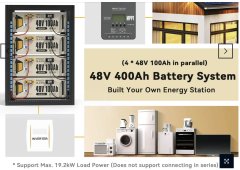Hi all,
I have the following question:
I want to create a off grid system that will comprise of the following components:
1. Victron Multiplus ii 5000va (1 at the begging and then maybe add another one, otherwise I will go with the 8000va)
2. Victron Lynx Power in (Initially 1 and later maybe a second one depended on the batteries I connect)
3. Victron Lynx Distributor (1 item)
4. Victron Lynx Shunt (1 item) (not sure about this maybe I will go with the simple shunt)
5. Victron Cerbo GX (1 item)
6. SmartSolar 150/85-Tr VE.Can (most likely 1 but maybe a second one later on)
7. 5kwp Solar (this the option of adding 2.2kwp)
8. Necessary fuses and disconnect where appropriate (I will seek an experts opinion on this)
9. Power Queen 48v 100ah batteries, most likely 4 for a total of 19.2kwh and here is the question.
The concept is to connect all Batteries directly to the Lynx Power In and not daisy chain them.
In the Power Queen website they state:
"Power Queen 48V Lithium Iron Phosphate Battery supports 4 batteries in parallel (4P), easily set up a 48V 400Ah Large Solar Battery System with 19.2kWh large capacity, support Max. 19.2kW Load Power (does not support connecting in series), meets the power requirements of a wide range of application scenarios. Allowing you to have your own energy station."
Does the above statement refer to daisy chain the batteries or even if they are independently connected to a buss bar which is the Power In?
Thank you in advance for your time
I have the following question:
I want to create a off grid system that will comprise of the following components:
1. Victron Multiplus ii 5000va (1 at the begging and then maybe add another one, otherwise I will go with the 8000va)
2. Victron Lynx Power in (Initially 1 and later maybe a second one depended on the batteries I connect)
3. Victron Lynx Distributor (1 item)
4. Victron Lynx Shunt (1 item) (not sure about this maybe I will go with the simple shunt)
5. Victron Cerbo GX (1 item)
6. SmartSolar 150/85-Tr VE.Can (most likely 1 but maybe a second one later on)
7. 5kwp Solar (this the option of adding 2.2kwp)
8. Necessary fuses and disconnect where appropriate (I will seek an experts opinion on this)
9. Power Queen 48v 100ah batteries, most likely 4 for a total of 19.2kwh and here is the question.
The concept is to connect all Batteries directly to the Lynx Power In and not daisy chain them.
In the Power Queen website they state:
"Power Queen 48V Lithium Iron Phosphate Battery supports 4 batteries in parallel (4P), easily set up a 48V 400Ah Large Solar Battery System with 19.2kWh large capacity, support Max. 19.2kW Load Power (does not support connecting in series), meets the power requirements of a wide range of application scenarios. Allowing you to have your own energy station."
Does the above statement refer to daisy chain the batteries or even if they are independently connected to a buss bar which is the Power In?
Thank you in advance for your time



